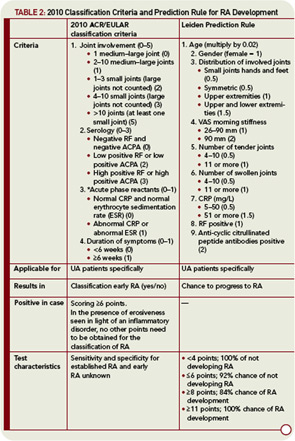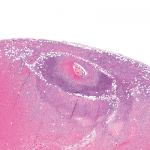Another question about the new ACR/EULAR criteria is whether they are entirely novel or influenced by the definition of RA embodied in the 1987 ACR criteria. To prevent circular reasoning, the outcome of the data-driven phase of the criteria development was not the expert’s opinion on the diagnosis of RA, but treatment of a UA patient with methotrexate within the first year. It is not clear whether this outcome really reduces the influence of circular reasoning. Generally, rheumatologists will prescribe methotrexate on the basis of their expert opinion that a patient has RA; however, having worked with the 1987 ACR criteria for about 20 years, clinicians may, consciously or unconsciously, refer to these criteria in their decision making.
Treatment with methotrexate as an outcome for assessing diagnosis also harbors the risk of misclassification on both sides. Patients with early UA who have another form of persistent arthritis (e.g., psoriatric arthritis) may be treated with methotrexate and would be classified in the RA group. Conversely, patients with characteristics of RA may have contraindications to, or side effects from, methotrexate and would be treated with another DMARD; these patients could be incorrectly classified in the non-RA group. It is hoped that, by the analysis of large numbers of patients, these effects can be leveled out. Nevertheless, these examples point to the difficulty of finding an appropriate gold standard for the diagnosis of early RA.
Another example of the difficulty in eliminating circular reasoning relates to the discussion on the inclusion of morning stiffness during the experts’ opinion phase in the development of the new criteria. Although duration of morning stiffness did not discriminate between the patients who did and did not receive methotrexate within one year of symptom onset, many experts felt that morning stiffness duration is a characteristic specific to RA. One may wonder to what extent this clinical impression is supported by the presence of morning stiffness in the 1987 ACR criteria. Eventually, it was decided not to include morning stiffness in the new set of criteria.
Although it is challenging to choose the best outcome measure for early RA, the 2010 set of ACR/EULAR criteria—which, according to the name, are still classification criteria—has a currently unknown sensitivity and specificity for the diagnosis of early RA. It will be interesting to wait for the 2011 ACR and EULAR meetings when, hopefully, many groups who have used these criteria in their own cohorts or clinical trials will report on their experience, and we can see how the criteria perform in various clinical and research settings.
The Prediction Rule
Given the intricacy and difficulty of deriving totally independent criteria for early RA, another option to identify early RA patients is to develop a predictive tool. For this purpose, the current classification criteria do not need to be changed. A prediction tool of this kind has recently been developed.7 This tool consists of nine variables: age, gender, distribution of involved joints, severity of morning stiffness, number of tender joints, number of swollen joints, C-reactive protein (CRP), RF, and anti-cyclic citrullinated peptide antibodies (see Table 2, p. 24). Intriguingly, these variables are quite similar to those in the 2010 ACR/EULAR criteria and contain elements of arthritis indicating joint pathology, inflammation, and autoantibodies. This prediction rule has been derived from prospective data and did not rely on expert opinion for its development. Although this rule was developed based on the experience of a single early arthritis cohort, it has an adequate discriminative ability and the predictive ability of this model has been validated in multiple worldwide studies.8–13

